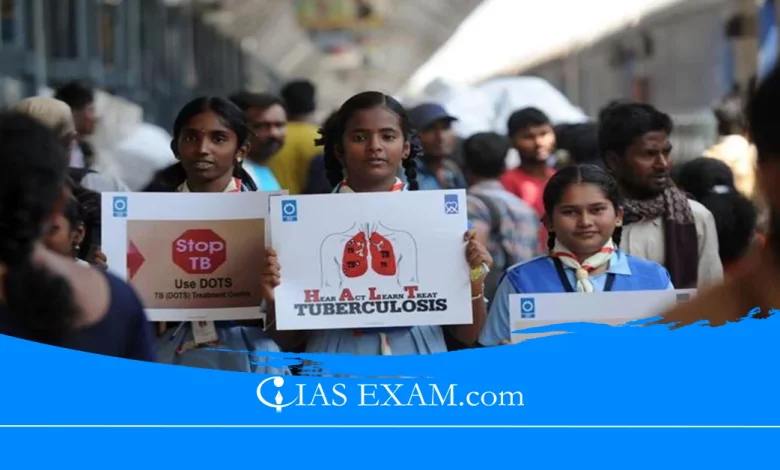Person-Centred TB Control in India
Syllabus: Social Issues, [GS - Paper 2]

Context
Recent report has just shown the need for person-centred action to introduce an effective path to TB termination in India which is otherwise known as Person-Centred TB Control in India. Despite the anticipated progress specified in the exclusive plans designed by competent health organisations signalling a healthier post-TB future, the reality has been quite slow which in turn has forced us to develop a strategic scheme that will prevent a possible crisis.
About Tuberculosis (TB)
- Tuberculosis is the major infectious disease that affects humanity through this hard drug, Mycobacterium tuberculosis which leads to the conditions injurious to the health system. Generally speaking, it is the lungs that are affected adversely, but there are other organs of the body that can become its targets.
- The spread of TB disease is gaining momentum and is signifying drops in our barriers as it passes via the air by infected individuals who cough or sneeze, this as a result has increased extra efforts towards addressing it and may be considered as among the old global health problems in fields with poorly structured healthcare systems especially in the resource-poor regions. Symptoms of TB sputum (chest), chest pain, sweating, short breath, weight loss, and fever may go along with this illness. As frequently, a complex therapy of several antibiotics administered orally is the treatment way for six months at least.
Earlier Methods of control for TB
- The traditional ways of handling tuberculosis by earlier eras used to consist of isolating cases and providing treatment in sanatoriums. As an additional point to this, we made it mandatory for people to follow some public health measures in order to prevent the spread of this disease.
- Several proven public health measures of TB were introduced, including identifying and isolating those who were diagnosed with the disease alongside contact tracing for people alleged to have been in close contact with those who were bedridden. There were campaigns of public education directed at drawing attention of the masses as to how this disease can be passed on, what its symptoms look like, and how to protect oneself from it. This also aimed at eradication of stigmatisation associated with the illness and early cases seeking diagnosis and medical attention.
- Measures taken to improve the living standards –ode to the substandard housing, sanitation , were spearheaded to contain the growing rate of tuberculosis which at the time was strongly linked to poverty and overcrowding.
- Bacterial vaccines; the BCG – bacterial vaccine that was developed in the early portion of the 20th century prevented tuberculosis (TB). The BCG vaccine has, yet, been applied to a certain extent in averting the severe forms of even TB in children but it is still weak in the control of TB. Hence, we must take up broader strategies in tackling this world health problem.
- The methods for tuberculosis control back in the day now serve as the starting point for the more advanced testing tools, treatments, and also prevention measures that are still in the process of being improved today.
The Present methodology of ‘Person-Centred TB Control’
- A patient-oriented approach to TB as a human, gender, financial, and social predicament, which is the most comprehensively moral disease, is essential due to the complexity of TB as a global healthcare challenge. TB is still known as the most deadly killer of the world as specified by the increasing cases and drug resistance especially in a particular country like India. Women, gender minorities are faced to overcome certain barriers to obtain care in areas that are often inseparable from poverty and environmental location.
- The hammer of TB is twofold, affecting both income and economy. Fortifying through community-based care, mental health support, eliminating stigmatisation and utilisation of technology are reckonable measures for reinforcement of TB management and control. Interventions such as STEPS system for tuberculosis elimination in the private health sector (STEPS) seek to fix the gaps, educating that personalised approaches are what should be prioritised when it comes to TB elimination.
Conclusion
- Therefore, this retrospective on tuberculosis in India reminds us of the importance of bringing individual dimensions and their particulars into focus. TB is the complicated issue that sometimes requires addressing multiple social, economic and health factors in a given specific situation, more long-term and general will be better.
- Via community based treatment of TB, a service for mental health and technology we can stir the struggle with spread of TB. STEPS, using the work environment as an example, is a good program that implements strategies preventing people from falling through the cracks and remembering that different people have different needs. Implementing the procedures mentioned could give light at the end of the tunnel with respect to the TB problem. Having a whole-scale cooperation is the best way to bring everybody to a healthy life after all.
Source: The Hindu
UPSC Mains Practice Question
Q.Discuss the significance of adopting person-centred approaches in tackling tuberculosis (TB) control in India. Highlighting the complexities of TB as a global health challenge, evaluate the effectiveness of community-based care, mental health support, and technology utilisation in addressing barriers to TB diagnosis and treatment access.





.png)



